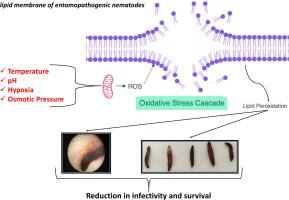Effect of various physical and chemical stress conditions on the infectivity and survival of Heterorhabditis indica and Steinernema feltiae: Relationship with lipid oxidative stress
IF 4.2
1区 农林科学
Q2 BIOCHEMISTRY & MOLECULAR BIOLOGY
引用次数: 0
Abstract
Entomopathogenic nematodes (EPNs) of the genera Heterorhabditis and Steinernema represent an alternative for the biological control of insects. The limited half-life of EPNs is still one of the most concerning issues in their commercialization. Lipid peroxidation (LPO) caused by reactive oxygen species (ROS) may be one of the most important causes of loss of infectivity and survival of EPNs when exposed to various physicochemical stress conditions (temperature, pH, hypoxia and osmotic pressure). Because LPO generates free radicals (FRs), it can trigger membrane peroxidation and lipid energy reserves of EPNs. However, in EPNs there is no data on the role of LPO on their physiology, making strategies for the conservation of derived biopreparations difficult. In this sense, the influence of LPO on the species of EPNs S. feltiae and H. indica under various conditions of physicochemical stress was studied. In both EPNs, the proposed stress conditions altered infectivity and survival over time, generating ROS associated with LPO with a variable tolerance depending on the species, type and time of exposure to stress. A relationship was observed between the LPO induced by stress conditions and infectivity-survival.

不同物理和化学胁迫条件对印度异habditis and steinnema feltiae感染和存活的影响:与脂质氧化应激的关系
虫病线虫(Heterorhabditis和Steinernema)是昆虫生物防治的一种选择。epn的有限半衰期仍然是其商业化中最受关注的问题之一。活性氧(ROS)引起的脂质过氧化(LPO)可能是epn暴露于各种物理化学胁迫条件(温度、pH、缺氧和渗透压)时丧失感染性和存活的最重要原因之一。由于LPO产生自由基(FRs),它可以触发epn的膜过氧化和脂质能量储备。然而,在epn中,没有关于LPO在其生理上的作用的数据,这使得保护衍生生物修复的策略变得困难。在此基础上,研究了LPO在不同物化胁迫条件下对EPNs S. feltiae和H. indica的影响。在这两种epn中,随着时间的推移,所提出的应激条件改变了传染性和存活率,产生与LPO相关的ROS,其耐受性取决于暴露于应激的物种、类型和时间。应激诱导的LPO与感染存活率之间存在一定的关系。
本文章由计算机程序翻译,如有差异,请以英文原文为准。
求助全文
约1分钟内获得全文
求助全文
来源期刊
CiteScore
7.00
自引率
8.50%
发文量
238
审稿时长
4.2 months
期刊介绍:
Pesticide Biochemistry and Physiology publishes original scientific articles pertaining to the mode of action of plant protection agents such as insecticides, fungicides, herbicides, and similar compounds, including nonlethal pest control agents, biosynthesis of pheromones, hormones, and plant resistance agents. Manuscripts may include a biochemical, physiological, or molecular study for an understanding of comparative toxicology or selective toxicity of both target and nontarget organisms. Particular interest will be given to studies on the molecular biology of pest control, toxicology, and pesticide resistance.
Research Areas Emphasized Include the Biochemistry and Physiology of:
• Comparative toxicity
• Mode of action
• Pathophysiology
• Plant growth regulators
• Resistance
• Other effects of pesticides on both parasites and hosts.

 求助内容:
求助内容: 应助结果提醒方式:
应助结果提醒方式:


